email_etiquette英文商务电邮写法教学
- 格式:pdf
- 大小:26.79 KB
- 文档页数:7
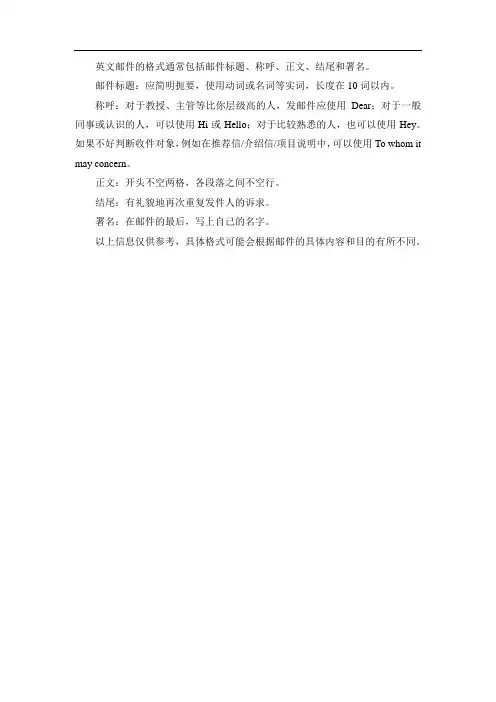
英文邮件的格式通常包括邮件标题、称呼、正文、结尾和署名。
邮件标题:应简明扼要,使用动词或名词等实词,长度在10词以内。
称呼:对于教授、主管等比你层级高的人,发邮件应使用Dear;对于一般同事或认识的人,可以使用Hi或Hello;对于比较熟悉的人,也可以使用Hey。
如果不好判断收件对象,例如在推荐信/介绍信/项目说明中,可以使用To whom it may concern。
正文:开头不空两格,各段落之间不空行。
结尾:有礼貌地再次重复发件人的诉求。
署名:在邮件的最后,写上自己的名字。
以上信息仅供参考,具体格式可能会根据邮件的具体内容和目的有所不同。
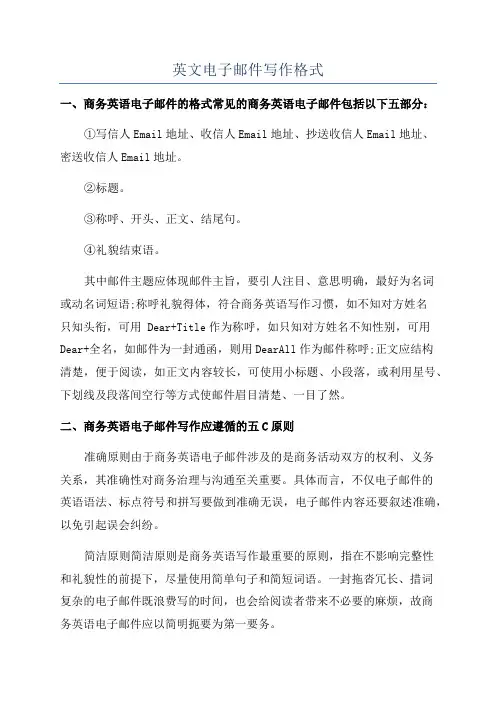
英文电子邮件写作格式一、商务英语电子邮件的格式常见的商务英语电子邮件包括以下五部分:①写信人Email地址、收信人Email地址、抄送收信人Email地址、密送收信人Email地址。
②标题。
③称呼、开头、正文、结尾句。
④礼貌结束语。
其中邮件主题应体现邮件主旨,要引人注目、意思明确,最好为名词或动名词短语;称呼礼貌得体,符合商务英语写作习惯,如不知对方姓名只知头衔,可用 Dear+Title作为称呼,如只知对方姓名不知性别,可用Dear+全名,如邮件为一封通函,则用DearAll作为邮件称呼;正文应结构清楚,便于阅读,如正文内容较长,可使用小标题、小段落,或利用星号、下划线及段落间空行等方式使邮件眉目清楚、一目了然。
二、商务英语电子邮件写作应遵循的五C原则准确原则由于商务英语电子邮件涉及的是商务活动双方的权利、义务关系,其准确性对商务治理与沟通至关重要。
具体而言,不仅电子邮件的英语语法、标点符号和拼写要做到准确无误,电子邮件内容还要叙述准确,以免引起误会纠纷。
简洁原则简洁原则是商务英语写作最重要的原则,指在不影响完整性和礼貌性的前提下,尽量使用简单句子和简短词语。
一封拖沓冗长、措词复杂的电子邮件既浪费写的时间,也会给阅读者带来不必要的麻烦,故商务英语电子邮件应以简明扼要为第一要务。
另外,为了节约时间和空间,电子邮件中可使用缩略语,如U表示you,Pls表示please,Info表示information,Qty表示quantity,P“C表示piece,L”C表示LetterofCredit,FOB表示FreeonBoard.例1 It is very difficult to sell man hole covers in France.This product must have the quality certificate issued in France.例2 Price:FOB Shanghai USD 96“PC.例3 Hope you can accept it.例1中的两个单句具有明显的因果关系,但写并不使用表达因果关系的连接词如since、because,这种舍长句、复合句,选短句、简单句,喜并列、弃从属的'句法特征在商务英语电子邮件写作中十分常见。
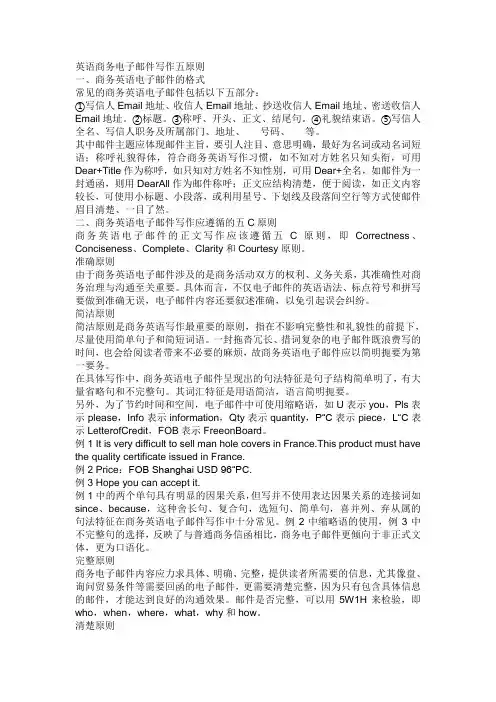
英语商务电子邮件写作五原则一、商务英语电子邮件的格式常见的商务英语电子邮件包括以下五部分:①写信人Email地址、收信人Email地址、抄送收信人Email地址、密送收信人Email地址。
②标题。
③称呼、开头、正文、结尾句。
④礼貌结束语。
⑤写信人全名、写信人职务及所属部门、地址、号码、等。
其中邮件主题应体现邮件主旨,要引人注目、意思明确,最好为名词或动名词短语;称呼礼貌得体,符合商务英语写作习惯,如不知对方姓名只知头衔,可用Dear+Title作为称呼,如只知对方姓名不知性别,可用Dear+全名,如邮件为一封通函,则用DearAll作为邮件称呼;正文应结构清楚,便于阅读,如正文内容较长,可使用小标题、小段落,或利用星号、下划线及段落间空行等方式使邮件眉目清楚、一目了然。
二、商务英语电子邮件写作应遵循的五C原则商务英语电子邮件的正文写作应该遵循五C原则,即Correctness、Conciseness、Complete、Clarity和Courtesy原则。
准确原则由于商务英语电子邮件涉及的是商务活动双方的权利、义务关系,其准确性对商务治理与沟通至关重要。
具体而言,不仅电子邮件的英语语法、标点符号和拼写要做到准确无误,电子邮件内容还要叙述准确,以免引起误会纠纷。
简洁原则简洁原则是商务英语写作最重要的原则,指在不影响完整性和礼貌性的前提下,尽量使用简单句子和简短词语。
一封拖沓冗长、措词复杂的电子邮件既浪费写的时间,也会给阅读者带来不必要的麻烦,故商务英语电子邮件应以简明扼要为第一要务。
在具体写作中,商务英语电子邮件呈现出的句法特征是句子结构简单明了,有大量省略句和不完整句。
其词汇特征是用语简洁,语言简明扼要。
另外,为了节约时间和空间,电子邮件中可使用缩略语,如U表示you,Pls表示please,Info表示information,Qty表示quantity,P“C表示piece,L“C表示LetterofCredit,FOB表示FreeonBoard。
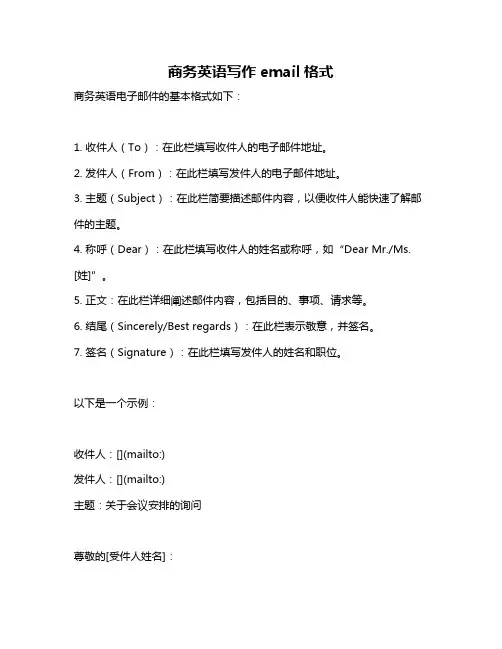
商务英语写作email格式
商务英语电子邮件的基本格式如下:
1. 收件人(To):在此栏填写收件人的电子邮件地址。
2. 发件人(From):在此栏填写发件人的电子邮件地址。
3. 主题(Subject):在此栏简要描述邮件内容,以便收件人能快速了解邮件的主题。
4. 称呼(Dear):在此栏填写收件人的姓名或称呼,如“Dear Mr./Ms. [姓]”。
5. 正文:在此栏详细阐述邮件内容,包括目的、事项、请求等。
6. 结尾(Sincerely/Best regards):在此栏表示敬意,并签名。
7. 签名(Signature):在此栏填写发件人的姓名和职位。
以下是一个示例:
收件人:[](mailto:)
发件人:[](mailto:)
主题:关于会议安排的询问
尊敬的[受件人姓名]:
您好!
我写信是想了解有关下周五会议的安排情况。
我们需要知道会议的具体时间、地点以及会议的主题。
如果您已经确定了这些信息,请尽快告知我们。
期待您的回复。
顺祝商祺!
[发件人姓名]
[发件人职位]。
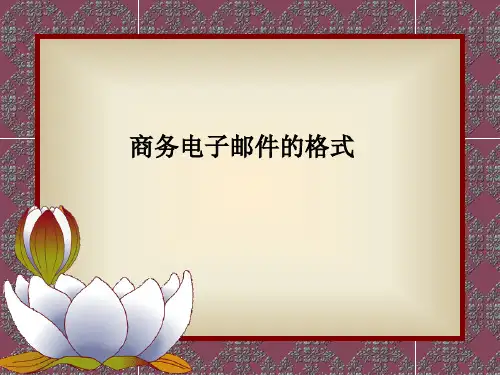
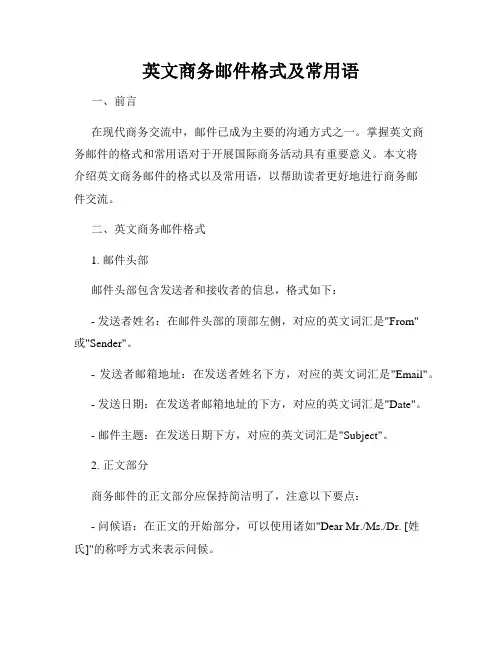
英文商务邮件格式及常用语一、前言在现代商务交流中,邮件已成为主要的沟通方式之一。
掌握英文商务邮件的格式和常用语对于开展国际商务活动具有重要意义。
本文将介绍英文商务邮件的格式以及常用语,以帮助读者更好地进行商务邮件交流。
二、英文商务邮件格式1. 邮件头部邮件头部包含发送者和接收者的信息,格式如下:- 发送者姓名:在邮件头部的顶部左侧,对应的英文词汇是"From"或"Sender"。
- 发送者邮箱地址:在发送者姓名下方,对应的英文词汇是"Email"。
- 发送日期:在发送者邮箱地址的下方,对应的英文词汇是"Date"。
- 邮件主题:在发送日期下方,对应的英文词汇是"Subject"。
2. 正文部分商务邮件的正文部分应保持简洁明了,注意以下要点:- 问候语:在正文的开始部分,可以使用诸如"Dear Mr./Ms./Dr. [姓氏]"的称呼方式来表示问候。
- 自我介绍:在问候语后,如果对方不熟悉你的身份,可进行自我介绍。
例如:"Allow me to introduce myself. My name is [你的姓名] and I am [你的职位/公司]。
"- 内容阐述:接下来,清晰地表达你要传达的信息或请求。
- 结尾部分:在邮件的结尾,使用类似"Best regards"或"Sincerely"等表达请求人的词汇,并签上你的姓名。
3. 附件如果邮件需要附带文件,则在正文部分结束后,使用英文词汇"Enclosed"或"Attached"来指明附件,并在最后列出附件的名称。
三、英文商务邮件常用语1. 开头常用语- "Dear Mr./Ms. [姓氏]":用于正式场合,对于不太熟悉的人或具有一定职务的人。
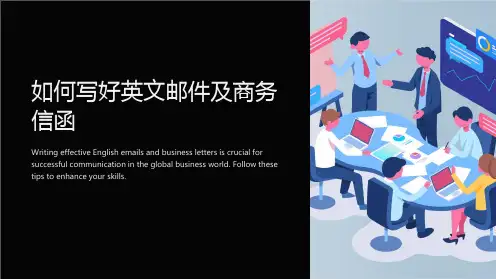
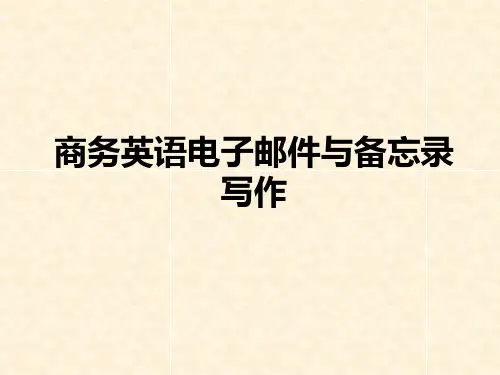
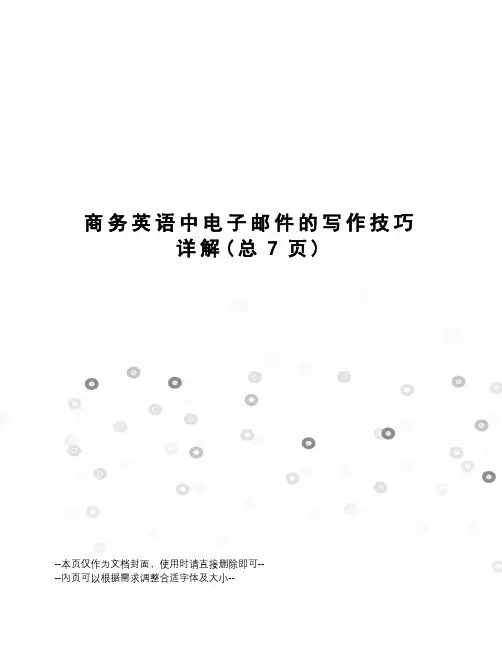
商务英语中电子邮件的写作技巧详解(总7页)--本页仅作为文档封面,使用时请直接删除即可----内页可以根据需求调整合适字体及大小--商务英语中电子邮件的写作技巧详解这是一篇由网络搜集整理的关于商务英语中电子邮件的写作技巧详解的文档,希望对你能有帮助。
随着全球经济的发展和市场化的运营,商务英语作为国际贸易用语变得越来越重要。
尤其是在我国加入WTO之后,我国的对外开放水平越来越高,外贸业务的日益增长,对国际商贸从业人员的商务书面沟通能力提出了更高的要求。
在对外商务贸易沟通交流中,商务英语电子邮件凭借其方便快捷的特点和便于搜索的优势,在现代商务中发挥着重要的作用。
但是,一些工作人员因为不重视商务英语中电子邮件的写作注意事项和相应的写作技巧,在无形中给个人和公司的发展带来负面影响,因此规范商务英语中电子邮件的写作尤为必要。
二、商务英语电子邮件写作中存在的问题1. 主题模糊邮件的主题应该体现邮件内容的精华。
通过邮件的主题来让收件人感觉到邮件内容的价值,让其能迅速做出打开邮件并且阅读的决定。
没有主题的邮件或主题模糊的邮件是非常不明智的,一方面这会造成浪费客户的时间,可能会因此失去潜在的客户,另一方面也是对客户的不尊重,很难让客户留下良好的印象,并且主题模糊或不写主题也会让写信人在以后的邮件搜索中遇到很大的困难。
主题模糊或没有主题的情况非常常见,比如,以下两种情况。
第一,Order (订单)。
在外贸行业中, order 包括很多种,其中有报价的订单、确认订单、发货订单,所以邮件中必须确定好主题。
如果是报价的订单应该写“quotation for order ”;如果是确认订单应该写“confirmationorder ”;如果是发货的订单就应该写上“dispatching order ”。
主题明确可以让收信人一目了然,否则会造成意思表达模糊的情况,最低可能导致交易失败。
第二,Contract (合同)。
同样在国际贸易中,合同也有好多种形式,其中在书面合同、电子合同、口头合同。
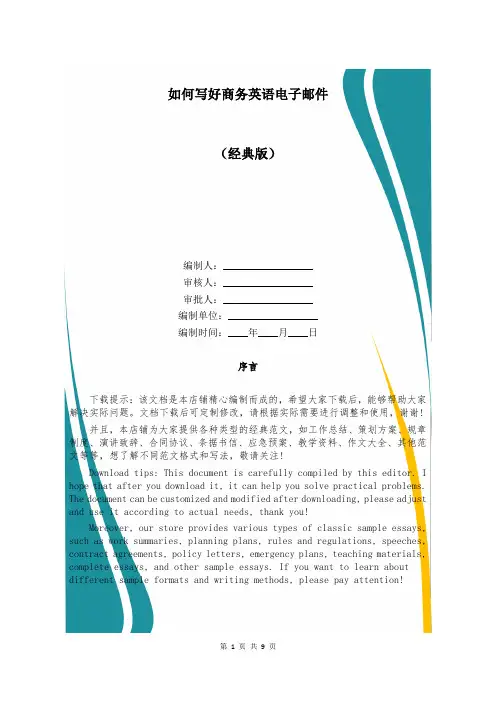
如何写好商务英语电子邮件(经典版)编制人:__________________审核人:__________________审批人:__________________编制单位:__________________编制时间:____年____月____日序言下载提示:该文档是本店铺精心编制而成的,希望大家下载后,能够帮助大家解决实际问题。
文档下载后可定制修改,请根据实际需要进行调整和使用,谢谢!并且,本店铺为大家提供各种类型的经典范文,如工作总结、策划方案、规章制度、演讲致辞、合同协议、条据书信、应急预案、教学资料、作文大全、其他范文等等,想了解不同范文格式和写法,敬请关注!Download tips: This document is carefully compiled by this editor. I hope that after you download it, it can help you solve practical problems. The document can be customized and modified after downloading, please adjust and use it according to actual needs, thank you!Moreover, our store provides various types of classic sample essays, such as work summaries, planning plans, rules and regulations, speeches, contract agreements, policy letters, emergency plans, teaching materials, complete essays, and other sample essays. If you want to learn about different sample formats and writing methods, please pay attention!如何写好商务英语电子邮件如何写好商务英语电子邮件电子邮件是一种用电子手段提供信息交换的通信方式,是互联网应用最广的服务。
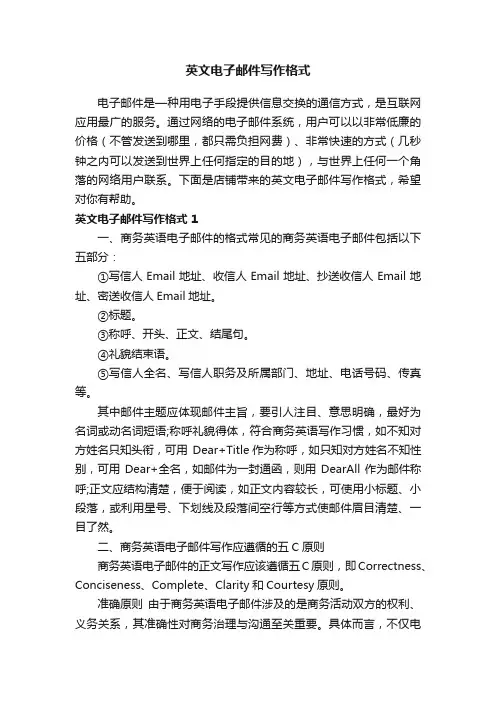
英文电子邮件写作格式电子邮件是—种用电子手段提供信息交换的通信方式,是互联网应用最广的服务。
通过网络的电子邮件系统,用户可以以非常低廉的价格(不管发送到哪里,都只需负担网费)、非常快速的方式(几秒钟之内可以发送到世界上任何指定的目的地),与世界上任何一个角落的网络用户联系。
下面是店铺带来的英文电子邮件写作格式,希望对你有帮助。
英文电子邮件写作格式 1一、商务英语电子邮件的格式常见的商务英语电子邮件包括以下五部分:①写信人Email地址、收信人Email地址、抄送收信人Email地址、密送收信人Email地址。
②标题。
③称呼、开头、正文、结尾句。
④礼貌结束语。
⑤写信人全名、写信人职务及所属部门、地址、电话号码、传真等。
其中邮件主题应体现邮件主旨,要引人注目、意思明确,最好为名词或动名词短语;称呼礼貌得体,符合商务英语写作习惯,如不知对方姓名只知头衔,可用Dear+Title作为称呼,如只知对方姓名不知性别,可用Dear+全名,如邮件为一封通函,则用DearAll作为邮件称呼;正文应结构清楚,便于阅读,如正文内容较长,可使用小标题、小段落,或利用星号、下划线及段落间空行等方式使邮件眉目清楚、一目了然。
二、商务英语电子邮件写作应遵循的五C原则商务英语电子邮件的正文写作应该遵循五C原则,即Correctness、Conciseness、Complete、Clarity和Courtesy原则。
准确原则由于商务英语电子邮件涉及的是商务活动双方的权利、义务关系,其准确性对商务治理与沟通至关重要。
具体而言,不仅电子邮件的英语语法、标点符号和拼写要做到准确无误,电子邮件内容还要叙述准确,以免引起误会纠纷。
简洁原则简洁原则是商务英语写作最重要的原则,指在不影响完整性和礼貌性的前提下,尽量使用简单句子和简短词语。
一封拖沓冗长、措词复杂的电子邮件既浪费写的时间,也会给阅读者带来不必要的麻烦,故商务英语电子邮件应以简明扼要为第一要务。
商务邮件写作步骤英文版邮件这样的沟通方式早已经渗入到了我们的生活工作中,因此可以说大多数人都能有效地使用邮件与他人交流。
但如果你发现自己还没做得足够有效,那么下面是为你整理的,希望对你有用!1、邮件开头称呼要恰当Start With an Appropriate SalutationSome people jump straight into the text of an email uch as a “hi”. It’s polite to add a salutation, just as you ight look like:有些人写邮件不喜欢加称呼,甚至连简单的“你好”都忽略,直接开始正文内容。
孰不知就像在传统的信件上一样,写上称呼是一种礼貌的象征。
称呼可以这样写:Dear Sir/Madam 亲爱的先生/女士Dear Mr. Johnson 亲爱的约翰逊先生Hi Sue 苏,你好Hello Fred 你好,福瑞德Your salutation needs to be appropriate. If you’re ployer, “Dear Mr. Johnson” is probably the best e that formality is ale is going to seem oddly stilted。
那么,是不是正式的用语就万能呢?绝对不是。
若你给你朋友的朋友写邮件,那用“亲爱的+姓”就显得异常别扭。
If in doubt, “Dear [first name]” eone out of the blue, don’t give them your life story before you makea request。
相信阅读你邮件的人不会愿意仔细浏览你那空洞无聊的长篇大论,所以你需要直奔主题。
如果你想写封邮件安慰某个心灵受伤的朋友,开头先把你的建议亮出来,然后再用你的亲身经历来辅助说明。
For personal use only in study and research; notfor commercial use英文电子邮件格式及范文[技巧] 英文电子邮件的基本要素是主题、称谓、正文、结尾用语及署名。
电子邮件最重要的部分是主题,假设我们都是很忙的人,在打开邮箱阅读邮件时,第一眼看到的就是邮件的主题。
所以,主题应当做到言简意赅并突出邮件重要性。
英文邮件的主题需要注意不超过35个字母,将位于句首的单词和专有名词首字母大写。
比如:Some questions about C++.在比较正式的格式中,需要把每个单词的首字母大写(介词、冠词除外)。
称谓如果是第一次给对方写信,那么称谓最好用“Dear+全名”,这样会让人感觉比较正式。
如果对方以非正式口吻来信,我们也可以类似非正式地回复。
比如:“Hello/Hi Lillian”。
在实际通信中可能遇到不知道对方姓名,可以用“Dear+对方头衔”,如“Dear President”,或者“Dear+Sir/Madam”形式。
英国人习惯在称呼后加“,”,美国人习惯在称谓后加“:”,有时也可以不加任何标点,是具体情况而定。
在书写正文时,把最重要的事情写在正文最前面或者邮件内容较长时写在第一段。
为了让收件人阅读邮件比较舒服,我们需要注意邮件正文结构的美感,邮件段落最好控制在两三段之内。
如果一封电子邮件涉及多个信息点,我们可以采用分条目的方法,如符号、小标题、编号来使得邮件想要表达的内容层次清晰。
邮件内容应注意单词的拼写、大小写、标点、语法等。
所谓以小见大。
结尾语在正文之后添加。
注意一般结尾语中只有第一个单词首字母大写而剩余单词都小写,此处与称呼不同。
一般电子邮件:Sincerely,Sincerely yours,私人电子邮件:Regards,Best wishes,Best regards,With best wishes,Wish best regards,Yours,Cheers,As ever,With love,Affectionately,......在正文最后需要署名,可以写全名,也可以只写名字。
英文商务邮件写作技巧随着全球化趋势的不断加强,跨国公司之间的商务邮件往来也越来越频繁。
而规范、准确、礼貌的英文商务邮件成为了一个优秀跨国商务人的基本技能。
下面小编将为大家提供几条英文商务邮件写作的技巧。
一、邮件的格式1.邮件开头通常以称呼和问候语开始,例如:Dear Mr./Mrs./Ms. Last name,I hope this email finds you well./How are you today?2.接下来,简明扼要地表达你的意图,并理由充分。
例如:I am writing to follow up on our previous conversation about the project deadline. Due to some unexpected issues that arose, we will need to extend the deadline by one week.3.在邮件结尾处,需要对接收方的反馈进行预期,或者感谢接收方的帮助。
例如:I look forward to hearing back from you soon.Thank you for your attention to this matter.4.附上你的联系方式。
例如:Best regards,Your nameCompanyPhone number二、注意邮件语言1.语言简洁清晰。
商务邮件应该采取简洁直观的语言,不要使用复杂、模糊、难懂的词语和短语。
2.注意用词准确。
商务邮件中用词应该准确无误,尤其是专业术语和缩写。
在涉及到时间、费用、数量等方面,不要出现歧义。
3.商务邮件应严肃、礼貌和专业。
发件人应该保持良好的态度和修养,不要在邮件中使用缩略词和口头话。
三、重视邮件主题1.邮件主题应该简明扼要、清晰明了。
主题应该简洁明了,让对方一目了然。
如果主题太长或者太复杂,难以清晰表达你的意思。
电子邮件格式正确写法英语作文English Answer:When writing an email, it is important to follow proper email etiquette to ensure clarity, professionalism, and respect. Here are some key elements of an effective email format:1. Subject Line: The subject line should be clear and concise, accurately reflecting the main purpose of the email. It should be short, no more than 50 characters, and should avoid using vague or generic terms.2. Salutation: Begin the email with a formal salutation, such as "Dear [Recipient's Name]". If you do not know the recipient's name, you can use a general greeting like"Hello there".3. Body: The body of the email should be well-organized and easy to read. Use short paragraphs, clear language, andspecific details to convey your message. Avoid using slang, jargon, or overly technical terms.4. Call to Action: If you need the recipient to take a specific action, clearly state it towards the end of the email. This could be a request for a response, a meeting schedule, or a file submission.5. Closing: End the email with a polite closing, suchas "Sincerely" or "Best regards".6. Signature: Include a professional signature that includes your full name, title, company, and contact information.Chinese Answer:写电子邮件时,遵守正确的电子邮件礼仪非常重要,以确保清楚、专业和尊重。
英文电子邮件写作格式英文电子邮件写作格式电子邮件是—种用电子手段提供信息交换的通信方式,是互联网应用最广的服务。
通过网络的电子邮件系统,用户可以以非常低廉的价格(不管发送到哪里,都只需负担网费)、非常快速的方式(几秒钟之内可以发送到世界上任何指定的目的地),与世界上任何一个角落的网络用户联系。
下面是店铺带来的英文电子邮件写作格式,希望对你有帮助。
英文电子邮件写作格式 1一、商务英语电子邮件的格式常见的商务英语电子邮件包括以下五部分:①写信人Email地址、收信人Email地址、抄送收信人Email地址、密送收信人Email地址。
②标题。
③称呼、开头、正文、结尾句。
④礼貌结束语。
⑤写信人全名、写信人职务及所属部门、地址、电话号码、传真等。
其中邮件主题应体现邮件主旨,要引人注目、意思明确,最好为名词或动名词短语;称呼礼貌得体,符合商务英语写作习惯,如不知对方姓名只知头衔,可用Dear+Title作为称呼,如只知对方姓名不知性别,可用Dear+全名,如邮件为一封通函,则用DearAll作为邮件称呼;正文应结构清楚,便于阅读,如正文内容较长,可使用小标题、小段落,或利用星号、下划线及段落间空行等方式使邮件眉目清楚、一目了然。
二、商务英语电子邮件写作应遵循的五C原则商务英语电子邮件的正文写作应该遵循五C原则,即Correctness、Conciseness、Complete、Clarity和Courtesy原则。
准确原则由于商务英语电子邮件涉及的是商务活动双方的权利、义务关系,其准确性对商务治理与沟通至关重要。
具体而言,不仅电子邮件的英语语法、标点符号和拼写要做到准确无误,电子邮件内容还要叙述准确,以免引起误会纠纷。
简洁原则简洁原则是商务英语写作最重要的原则,指在不影响完整性和礼貌性的前提下,尽量使用简单句子和简短词语。
一封拖沓冗长、措词复杂的电子邮件既浪费写的时间,也会给阅读者带来不必要的麻烦,故商务英语电子邮件应以简明扼要为第一要务。
Professional Email Etiquette in 11 Easy Steps Dr. Marianne Di Pierro, Director, Graduate Center for Research and Retention Western Michigan University
In our everyday worlds, we rely almost exclusively upon email as a mode of communication and correspondence. Yet, many graduate students, as well as others who reside in the university community with us, do not understand or appreciate the fundamental uses, and abuses, of email. Further, in many instances, the transmission of email has taken on a kind of rapid-fire shorthand, in which the sender and receiver appear to be shrouded in an unfortunate anonymity, instead of regarded as real people. Knowing the rules of etiquette and applying them, before you hit the “Send” button, can save you from inadvertent difficulties, embarrassment, and regret.
1. Address Email Recipients by Name: The highest compliment you can pay to someone is to use his/her name. Make certain to address the individual to whom you plan to send your email by using his or her name and appropriate title. If the individual is a professor, avoid using the professor’s first name, unless you have a clearly established relationship which permits for this type of informality. In other words, you both have agreed to employ “first” names in your interactions. It is appropriate to use the following: Dear Dr. Smith; Hello Dr. Smith; Greetings Dr. Smith; Dear Professor Smith, for example. This information represents the salutation of your email – your greeting, and placing it in this manner helps the receiver to understand that he or she is the intended recipient of the email. Do not imply the salutation by thinking that the use of an individual’s email address alone suffices or compensates for the lack of a salutation. It doesn’t. An email sent without an appropriate salutation may exert a negative impression and can be likened to a kind of “Hey you,” instead of a more polite address that considers the value of a person’s name – and by extension, that person. In communications with faculty, administrators, and staff, it is best to maintain a more formal stance, unless of course, you have an established informal relationship with these individuals: in other words, you both know each other and have encouraged a more informal manner of address. 2. Identify Yourself and State Briefly Your Intentions: Your first act of business in the email is to identify yourself and state briefly your intended reason for sending the email. Professors and administrators receive scores of email every day, and from multiple constituencies. Therefore, it is important for you to state briefly the reason for your email:
Dear Dr. Smith, The purpose of my email is to remind you of our previous meeting on June 2, 2013, when you provided an overview of my Graduate Student Research Grant application. During that meeting, you asked me to re-write the proposal and submit it to you for your final approval. That document is attached.
Dear Dr. Smith, My name is John Smith, and I am a graduate student in your on-line course, ENG 7888: The 19th Century Novel. I have encountered some difficulty with the course and would like to speak with you about ways that I can be successful. I would appreciate your advice and am interested in scheduling an appointment. Please let me know your availability.
Note the brevity of the information contained in the body of the email. The information is direct, succinct, and it captures in a few sentences 1. the identity of the writer and 2. the purpose of the communication. In both instances, the professor has received all of the information necessary to address the students’ requests: A. Review the next draft of a grant proposal; B. Schedule an appointment.
3. Write a Definitive Subject Heading: Due to the fact that we all receive numerous email every day, it is important also to distinguish the purpose of the email in the subject heading. Recipients may frequently delete email that does not clearly capture the reason for the communication, as provided in the subject heading. In addition, many of us are trained to be on the alert for spam and viruses, and so may delete email without opening it and reading further to decipher the purpose. Therefore, the information in the subject heading is critical in capturing the recipient’s attention. Possible subject headings appropriate to the examples in item #2 could read as follows: